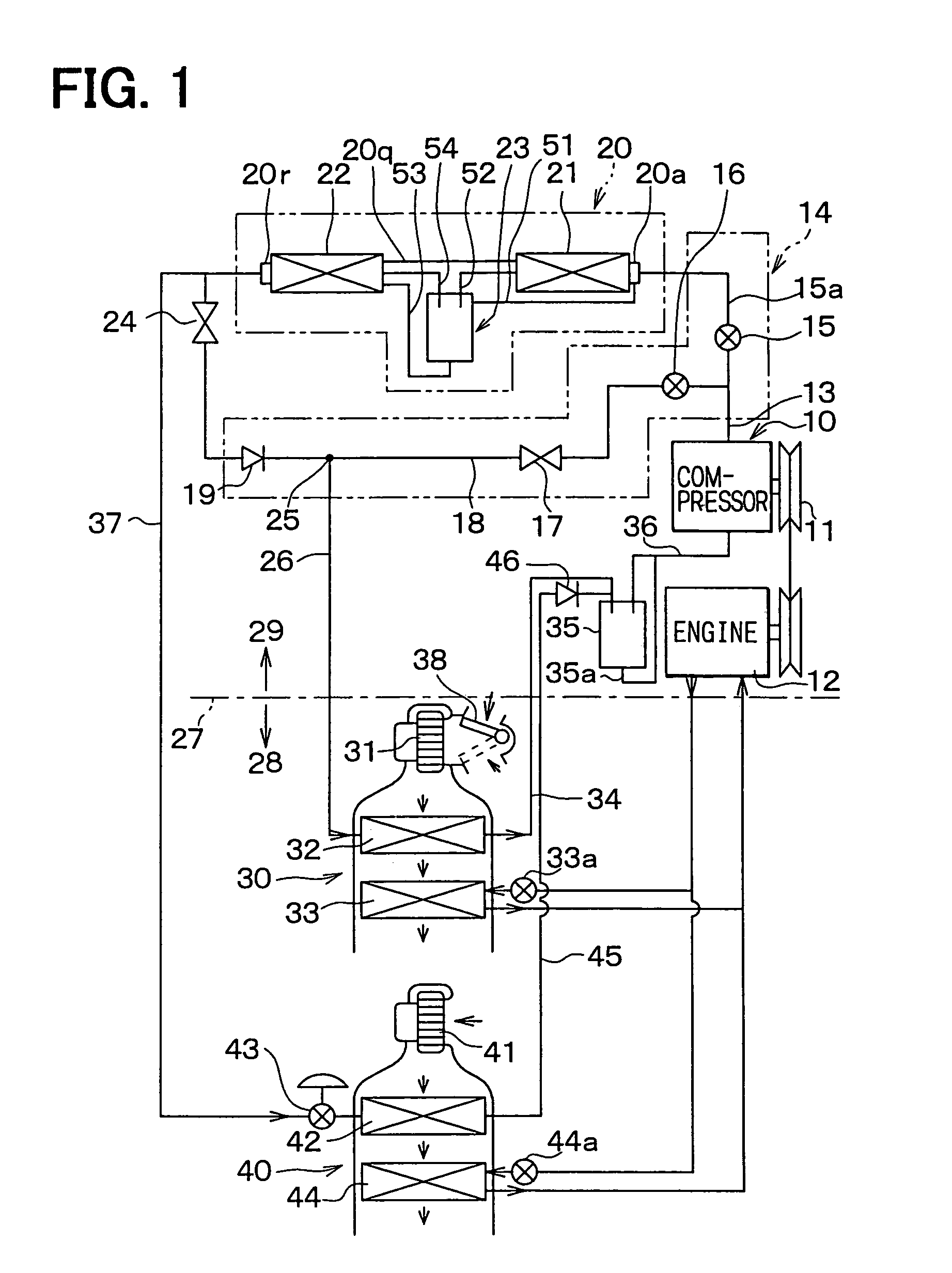Vehicle air conditioner with front and rear air conditioning units
a technology for air conditioners and vehicles, which is applied in the direction of compression machines with several condensers, light and heating apparatus, transportation and packaging, etc. it can solve the problems of complicated refrigerant piping structure in the engine compartment and difficulty in ensuring the arrangement space of refrigerant piping, so as to achieve simple connection structure and simple structure of the check valv
- Summary
- Abstract
- Description
- Claims
- Application Information
AI Technical Summary
Benefits of technology
Problems solved by technology
Method used
Image
Examples
first embodiment
(First Embodiment)
[0018]The first embodiment of the present invention will be now described with reference to FIGS. 1–3. In the first embodiment, the present invention is typically applied to a dual-type air conditioner for a vehicle having a wide passenger compartment space, such as one-box type recreational vehicle (RV).
[0019]As shown in FIG. 1 and FIG. 2, the dual-type air conditioner has a front air conditioning unit 30 for performing an air conditioning in a front seat area of a passenger compartment 28, and a rear air conditioning unit 40 for performing an air-conditioning in a rear seat area of the passenger compartment 28. The front air conditioning unit 30 is disposed inside of a dashboard (not shown) at the forefront of the passenger compartment 28. The rear air conditioning unit 40 is disposed in a sidewall of a vehicle body, adjacent to the right sidewall portion or the left sidewall portion of the passenger compartment 28 on the rear seat side.
[0020]A compressor 10 is d...
second embodiment
(Second Embodiment)
[0065]The second embodiment of the present invention will be now described with reference to FIG. 4. As shown in FIG. 4, in the second embodiment, an outlet piping 35c is inserted into a cylindrical main body 35b of the gas-liquid separator 35. In the outlet piping 35c, a fine throttle hole is opened so as to be used as the liquid return throttle path 35a.
[0066]The outlet piping 35c is inserted into the cylindrical main body 35b from a bore portion 35d in the bottom of the cylindrical main body 35b, and is joined integrally to the cylindrical main body 35b around the outlet piping 35c by soldering or the like. In the outlet piping 35c, adjacent to the bottom portion of the cylindrical main body 35b, the liquid return throttle path 35a is formed to suck a liquid refrigerant around the bottom of the cylindrical main body 35b into the outlet piping 35c.
[0067]A gas refrigerant inlet 35e is bored in the top end of the outlet piping 35c to suck the gas refrigerant acc...
third embodiment
(Third Embodiment)
[0071]The third embodiment of the present invention will be now described with reference to FIG. 5. In the third embodiment, as shown in FIG. 5, the structure of the check valve 46 is made simple. In the third embodiment, the rear refrigerant outlet pipe 45 is not divided. At a position adjacent to the downstream end of the rear refrigerant outlet pipe 45, a reduced portion 45c having a reduced passage area is integrally formed, so that the reduced portion 45c is used as the seat 46c described in the second embodiment.
[0072]That is, when refrigerant flows reversely from the gas-liquid separator 35 to the rear refrigerant outlet pipe 45 (to the side of the rear evaporator 42), the O-ring 46j attached on the periphery of the valve body 46b is elastically fitted onto the wall of the reduced portion 45c to close the passage. Thus, a reverse flow of the refrigerant is avoided.
[0073]On the contrary, when refrigerant flows from the rear refrigerant outlet pipe 45 toward t...
PUM
 Login to View More
Login to View More Abstract
Description
Claims
Application Information
 Login to View More
Login to View More - R&D
- Intellectual Property
- Life Sciences
- Materials
- Tech Scout
- Unparalleled Data Quality
- Higher Quality Content
- 60% Fewer Hallucinations
Browse by: Latest US Patents, China's latest patents, Technical Efficacy Thesaurus, Application Domain, Technology Topic, Popular Technical Reports.
© 2025 PatSnap. All rights reserved.Legal|Privacy policy|Modern Slavery Act Transparency Statement|Sitemap|About US| Contact US: help@patsnap.com



